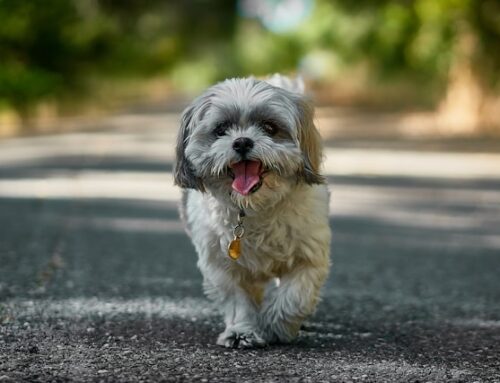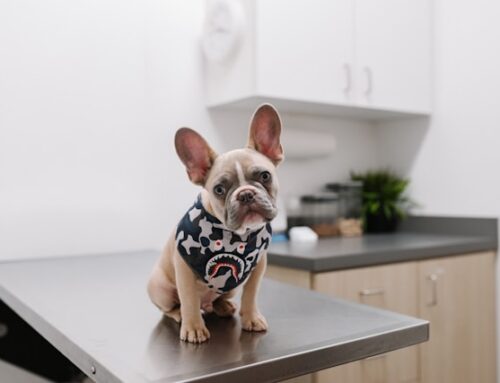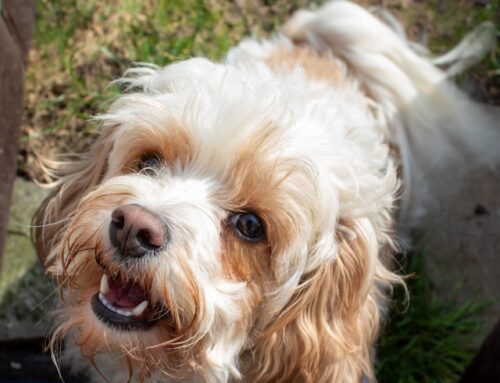Overview
Introduction to Potty Training Puppy
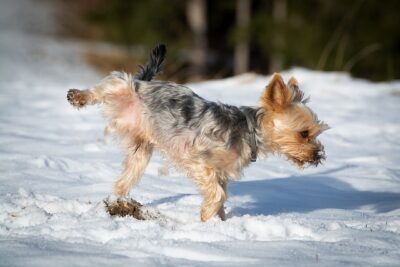
Embarking on the journey of potty training your puppy in 2024 can be both exciting and challenging. It marks a significant step in your puppy’s development and strengthens the bond between you.
Adopting a positive approach to potty training not only accelerates the learning process but also nurtures a trusting and respectful relationship with your furry companion.
In this comprehensive guide, we’ll explore effective strategies, tips, and techniques to make the potty training experience a success for you and your puppy.
What is Potty Training?
Potty training, also known as house training, is the process of teaching your dog where and when it is appropriate to relieve themselves. It involves teaching your dog to eliminate outdoors or in a designated indoor area, rather than inside your home. Potty training is essential for maintaining a clean and hygienic living environment and preventing accidents.
It’s important to note that potty training regression can occur, especially in very young puppies, so consistency and patience are key. Some owners use puppy pads to help with training, especially for young puppies who may not be able to hold their bladder for long periods.
Importance of Potty Training Puppy
Potty training is crucial for your puppy to become house trained and avoid accidents inside your home. Teaching your puppy where to pee helps prevent house soiling and reduces the risk of developing separation anxiety.
Consistent potty training establishes good habits early on, ensuring a happier and cleaner living environment for both you and your furry friend. When teaching your puppy where to pee, use a leash to guide them to the designated potty area.
At night, it’s important to take your puppy out before bed and immediately when they wake up to prevent accidents while they sleep. With patience and a consistent schedule, your puppy will learn where it’s appropriate to relieve themselves.
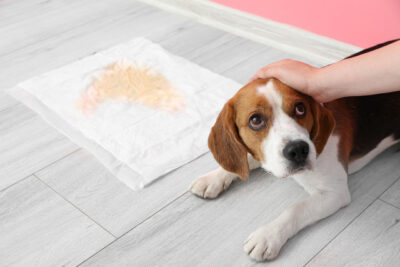
Preparing for Potty Training Puppy
Getting the Right Supplies
Preparing for potty training involves gathering the right supplies to set your puppy up for success. Essential items include pee pads or potty pads for indoor training, or a designated outdoor area for your puppy to go potty.
A crate can be useful for training, providing a safe space for your puppy and aiding in house training. Using a leash for outdoor potty breaks helps guide your puppy to the designated area.
Treats can be used as rewards for successful potty trips, reinforcing good behavior during the training process. Remember to consider your puppy’s diet and feeding times when planning your potty training schedule.
Setting Up a Designated Potty Area
Preparing for potty training involves setting up a designated potty area for your puppy. Choose a spot outside that is easily accessible and consistently use the same spot to help your puppy recognize it as their potty area.
For indoor training, consider using pee pads or a litter box, especially if you have a new pet or live in an apartment. Setting up a designated potty area helps prevent house soiling and establishes a routine for your puppy.
If you’re using an indoor area, the laundry room or bathroom can be good options due to their easy-to-clean surfaces.
Establishing a Potty Training Schedule
Preparing for potty training involves establishing a consistent potty training schedule for your puppy. Plan regular potty breaks after meals, as dogs often need to go potty shortly after eating. Designate specific times for your puppy to go potty and take them to the designated area each time.
Incorporate feeding times into your schedule to regulate when your puppy needs to go potty. Consistency in the schedule helps reinforce the potty training routine and teaches your puppy when and where it’s appropriate to go potty.
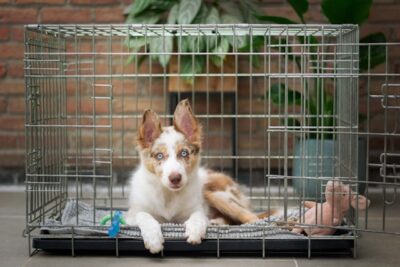
Potty Training Puppy Methods
Crate Training for Potty Training Puppy
Crate training is a popular method for potty training puppies. The idea behind crate training is to use the natural den instinct of dogs to create a safe and comfortable space for them. Dogs are less likely to soil their sleeping area, so a crate can be a helpful tool in house training.
When using crate training for potty training, it’s essential to gradually accustom your puppy to the crate and use it appropriately. Ensure the crate is the right size for your puppy and never use it as a form of punishment.
Paper Training
Paper training is another method for potty training puppies, especially useful for those living in apartments or during cold weather. It involves teaching your puppy to go potty on newspaper or training pads placed in a designated indoor area.
To start, place the training pads in a small area and gradually move them closer to the door leading outside. This method can be effective, but consistency is key, as well as gradually transitioning your puppy to outdoor potty training.
Litter Box
Using a litter box for potty training is a common method for small dog breeds or for owners living in apartments or homes without easy outdoor access. To train your puppy to use a litter box, place them in the box after meals and when they wake up, as dogs often need to go potty at these times.
Use positive reinforcement, such as treats and praise, when your puppy uses the litter box correctly. Gradually move the litter box closer to the door leading outside to transition your puppy to outdoor potty training.
Outdoor Potty Training
Outdoor potty training involves teaching your puppy to go potty outside. Take your puppy outside after meals, when they wake up, and before bedtime, as well as every few hours during the day. Watch for signs such as barking or circling, which indicate they need to go.
When your puppy goes potty outside, praise them and give them a treat to reinforce the behavior. Be patient and consistent, and gradually increase the time between potty breaks as your puppy learns to hold it longer.
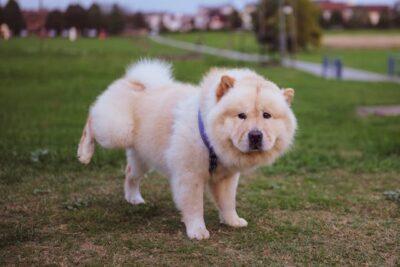
Getting Started with Potty Training Puppy
Introducing Your Puppy to the Potty Area
Maintaining potty training success includes introducing your puppy to the designated potty area. Decide on a specific spot outside where you want your puppy to go potty and consistently take them there.
Use a verbal cue, like “go potty,” when they eliminate, and reward them with praise and a treat to reinforce the behavior. Regular walks and consistent feeding schedules can also help regulate your puppy’s potty habits.
Using Positive Reinforcement
Maintaining potty training success involves using positive reinforcement to encourage your puppy to go potty in the right place.
When your dog pees outside, praise them and offer a small treat to reinforce the behavior. Consistency in rewarding your puppy for going potty outside will help them learn and remember the desired behavior.
Recognizing Signs That Your Puppy Needs to Go
Maintaining potty training success involves recognizing the signs that your puppy needs to go potty. Watch for behaviors like sniffing around, barking, circling, or whining, as these can indicate that your puppy needs to go outside.
By paying attention to these cues and promptly taking your puppy outside, you can help prevent accidents indoors and reinforce good potty habits.
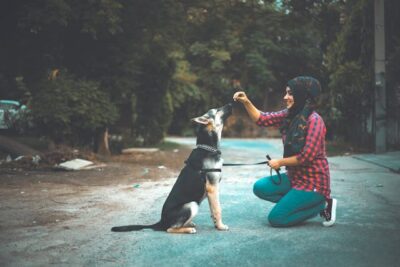
Puppy Potty Training Puppy Techniques
Establishing a Routine
Establishing a routine is key to successful potty training puppy. Monitor your pup’s behavior, especially after meals, playtime, or waking up, as these are times they’re likely to need to go. Take them to the designated potty area and wait for them to do their business.
Use positive reinforcement like treats and praise when they go in the right spot. Be patient and consistent, and gradually increase the time between potty breaks as your pup learns to hold it for longer periods.
Remember, accidents may happen, but with time and practice, your pup will learn to go potty outside.
Using Commands and Cues
Using commands and cues can greatly aid in puppy potty training. For example, you can use a phrase like “go potty” or a specific word like “business” consistently when you take your pup to the designated potty area.
This helps them associate the command with the action of eliminating. Tips and tricks include being patient and consistent, praising and rewarding your pup immediately after they go potty in the right spot, and avoiding punishment for accidents.
With time and practice, your pup will learn to understand and respond to the command, making potty training more effective.
Dealing with Accidents
Dealing with accidents is a normal part of puppy potty training. When accidents happen, it’s important not to punish your pup; instead, clean up the mess thoroughly to remove any lingering scent. Use an enzymatic cleaner to neutralize odors and discourage repeat accidents in the same spot.
Keep an eye on your pup’s behavior and schedule to prevent accidents by taking them out frequently, especially after eating, drinking, or waking up. Consistency and positive reinforcement are key; with time, your pup will learn where it’s appropriate to potty.
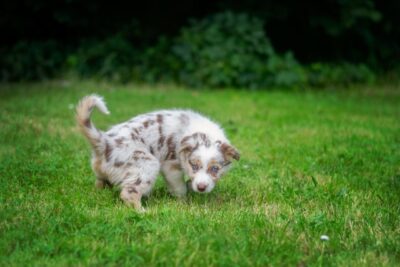
Progressing Through Potty Training Puppy
Gradual Increase in Potty Training Area
Progressing through potty training involves gradually increasing your pup’s potty training area. Start by confining them to a small, easy-to-monitor space, then gradually expand their access as they become more reliable. Use gates or playpens to section off larger areas of your home as your pup learns.
Monitor their behavior closely during this transition period and be prepared to take them outside more frequently if accidents occur. Consistency is key; stick to a schedule and continue using positive reinforcement to reinforce good potty habits.
Extending Time Between Potty Breaks
Progressing through potty training involves gradually extending the time between potty breaks for your pup. Start by watching your dog closely for signs like barking or circling, which indicate they need to go. Take them outside immediately after eating, drinking, playing, or waking up, and reward them with a treat when they do their business outdoors.
If accidents happen indoors, don’t scold your pup; instead, clean up the mess thoroughly to remove any scent. With consistency and patience, your dog will learn to wait longer periods between potty breaks and become reliably house trained.
Celebrating Successes
Celebrating successes is key to progressing through potty training. When your pup pees or poops outside, praise them enthusiastically and give them a treat to reinforce the behavior. Keep a close eye on your dog, especially during times when accidents are more likely, like after meals or playtime.
If your pup has an accident indoors, clean it up thoroughly to remove any lingering scent. With consistent positive reinforcement, your dog will learn to associate going potty outside with good things, making house training a more successful and rewarding experience.
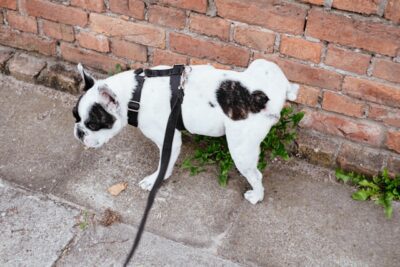
Troubleshooting Potty Train Puppy Issues
Dealing with Regression
Dealing with regression in puppy potty training is a common challenge. If your trained dog starts having accidents indoors again, revisit the basics by taking them out more frequently, especially after meals and naps.
An older dog may experience issues such as changes in their digestive system or urinary tract infections, which can contribute to accidents indoors. Address any medical concerns with your vet and ensure your dog’s diet is suitable for their age and health. Watch for signs that they need to go, such as sniffing around or circling, and take them outside immediately.
Ensure your dog’s diet is suitable for their age and breed to avoid digestive issues that could contribute to accidents. If separation anxiety is a factor, work on gradually desensitizing your dog to being alone and providing them with a comfortable space when you’re away.
Consistent training and reinforcement of previously mentioned tips can help your dog get back on track with their potty training. Remember that patience and understanding are key, as every dog learns at their own pace.
Addressing Marking Behavior
Addressing marking behavior in puppies requires patience and consistency. If your puppy starts marking indoors, clean up the area thoroughly to remove any scent. Keep a close eye on your puppy and immediately rush them outside if you see them starting to mark.
Consider neutering or spaying your puppy, as this can reduce marking behavior. Ensure your puppy’s diet is appropriate and that they are getting enough outdoor time for potty breaks.
With consistent training and supervision, you can help your puppy overcome marking behavior and become reliably house trained.
Handling Submissive or Excitement Urination
Handling submissive or excitement urination in puppies requires understanding and patience. Submissive urination often occurs when a puppy feels intimidated or overly excited, leading to involuntary urination.
To address this, avoid direct eye contact, crouching over your puppy, or speaking in a loud or excited tone. Instead, approach your puppy calmly and gently, using a soft tone of voice. Provide plenty of positive reinforcement for appropriate potty behavior and avoid punishing or scolding your puppy for accidents.
Consistent training, patience, and understanding can help your puppy overcome submissive or excitement urination.
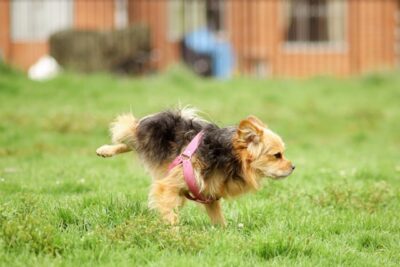
Maintaining Potty Training Puppy Success
Consistency in Routine and Reinforcement
Maintaining potty training success requires consistency in both routine and reinforcement. Stick to a regular schedule for feeding, potty breaks, and walks to help your dog know what to expect.
Reinforce good behavior with praise, treats, and positive attention every time your dog goes potty outside to reinforce the desired behavior.
Regularly Scheduled Potty Breaks
Maintaining potty training success includes taking your puppy out for regularly scheduled potty breaks. Puppies have small bladders and may need to go out every few hours, especially after eating, drinking, playing, or waking up.
Establishing a consistent routine for potty breaks can help prevent accidents indoors and reinforce good potty habits.
Monitoring and Adjusting as Your Puppy Grows
Maintaining potty training success involves monitoring and adjusting your approach as your puppy grows. Puppies’ bladder control improves as they age, so you may need to gradually increase the time between potty breaks.
Keep an eye on their behavior and adjust your schedule accordingly to ensure they stay well-house trained.
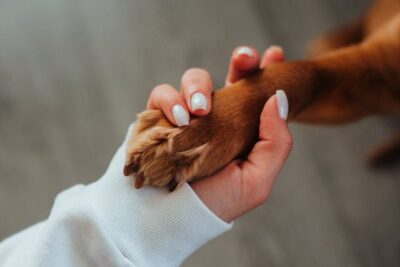
Celebrating Potty Training Puppy Milestones
Graduating from Potty Training Puppy
Celebrating potty training milestones is a rewarding part of raising a puppy. When your pup graduates from potty training and consistently goes potty outside, celebrate their achievement with praise, treats, and maybe even a special toy. Remember to continue reinforcing good habits to maintain their success.
Transitioning to Full House Privileges
Celebrating potty training milestones includes transitioning your pup to full house privileges. As your puppy becomes more reliable with their potty habits, gradually allow them more freedom indoors.
Monitor their behavior closely and be prepared to intervene if accidents occur, but celebrate their progress as they gain more independence in the house.
Tips for Long-Term Potty Training Success
Celebrating potty training milestones involves maintaining long-term success. Continue to provide regular potty breaks, especially after meals and naps, and praise your pup for going potty outside.
Consistency in your routine and positive reinforcement will help solidify good habits for the long term.
Conclusion: Potty Training Puppy
Recap of Benefits of Potty Training Puppy
Potty training your puppy is a crucial step in their development, ensuring a clean and hygienic living environment. It helps prevent house soiling, reduces the risk of developing separation anxiety, and establishes good habits early on.
Consistent potty training fosters a trusting and respectful relationship between you and your puppy, strengthening your bond and setting the foundation for a happy and healthy life together.
Final Thoughts on Potty Training Puppy
Potty training your puppy is a challenging but rewarding experience that requires patience, consistency, and understanding. It’s important to approach potty training with a positive attitude, celebrating successes and addressing challenges with compassion.
By following effective strategies, tips, and techniques, you can successfully potty train your puppy and enjoy a cleaner, happier living environment together.
Continuing to Build a Strong Bond Through Training
Potty training is just one aspect of building a strong bond with your puppy. Continuing to train and socialize your puppy will help them become a well-behaved and well-adjusted companion.
Use positive reinforcement and consistency in your training to reinforce good behavior and strengthen your bond. Remember, training is an ongoing process that requires patience and dedication, but the rewards of a well-trained and happy puppy are well worth the effort.
At Little Puppies Online, we understand the importance of proper training and socialization for your puppy’s well-being. That’s why we offer puppies for sale in Ohio and surrounding areas that are thoughtfully bred and raised by reputable breeders. From day one, we value and adore each and every charming canine in our care.
Our puppies receive regular health checks, socialization, and affectionate interaction to ensure they meet your expectations. Explore our delightful selection of puppies for sale in Ohio, where each furry friend is raised with love and care to become a cherished addition to your family. Adopt your new companion today.
Frequently Asked Questions (FAQs): Potty Training Puppy
- How do I house train my puppy?
- House training your puppy involves establishing a routine for feeding, bathroom breaks, and walks. Supervise your puppy closely, especially after meals, playtime, or waking up, as they’re more likely to need to go.
- How many dogs can I train at once?
- It’s best to focus on one dog at a time for potty training. This allows you to give each dog the attention and consistency they need to learn effectively.
- How do I prevent my puppy from being distracted during potty breaks?
- Keep potty breaks short and focused. Avoid playtime or walks during bathroom breaks to help your puppy understand the purpose of the outing.
- What should I do if my puppy has an accident in the house?
- Clean up accidents promptly using an enzymatic cleaner to remove the scent, which can attract your puppy to repeat the behavior in the same spot.
- How do I teach my puppy to poop outside?
- Take your puppy outside to their designated potty area after meals, playtime, and waking up. Use a command like “go potty” and praise them when they eliminate outside.
- My puppy forgets to go outside. What should I do?
- Be patient and consistent with your training. Stick to a regular schedule, and supervise your puppy closely to prevent accidents.
- Should I feed my puppy before bedtime?
- Avoid feeding your puppy a large meal right before bedtime to reduce the likelihood of overnight accidents. However, ensure they have access to water.
- How many hours can a puppy hold their bladder at night?
- Puppies can typically hold their bladder for about one hour per month of age, up to a maximum of about eight hours. However, this varies based on the individual puppy.
- Should I take my puppy to the vet for potty training issues?
- If your puppy is having persistent potty training issues, it’s a good idea to consult with your vet to rule out any underlying medical conditions.
- What should I do first thing in the morning with my puppy?
- Take your puppy outside to their designated potty area as soon as you wake up, as they are likely to need to go after a night’s sleep.


